

Compact Muon Solenoid
LHC, CERN
| CMS-PAS-HIN-20-002 | ||
| Elliptic anisotropy measurement of the f0(980) hadron in proton-lead collisions and evidence of its quark-antiquark composition by CMS | ||
| CMS Collaboration | ||
| 2 September 2023 | ||
| Abstract: Despite its discovery half a century ago, the question about the quark content of the f0(980) hadron has not been settled, whether its being an ordinary quark-antiquark meson, a tetraquark exotic state, a kaon-antikaon molecule, or a quark-antiquark-gluon hybrid. In this note, evidence that the f0(980) hadron is an ordinary quark-antiquark meson is reported, by employing the number-of-constituent-quark (NCQ) scaling of elliptic flow anisotropies (v2), empirically established by conventional hadrons up to transverse momentum (pT) of about 10 GeV/c in relativistic heavy ion collisions. The f0(980) is reconstructed via the invariant mass of its main decay channel f0(980)→π+π− in proton-lead collisions recorded by the CMS experiment at the LHC. The f0(980) yield is measured relative to the second-order symmetry plane as reconstructed from the energy deposited in the forward/backward region of the CMS detector, and its v2 parameter is extracted as a function of pT. It is found that the f0(980) explanation as an ordinary quark-antiquark state is preferred over a tetraquark or K¯K molecule hypothesis at 7.7, 6.3, or 3.1 standard deviations in the pT< 10, 8, or 6 GeV/c ranges, respectively. The quark-antiquark hypothesis is also preferred by 3.5 standard deviations over the pT< 8 GeV/c range for nq= 3, characteristic of a quark-antiquark-gluon hybrid state. The first determination of the f0(980) state quark content with high confidence using this novel approach advances the study of quantum chromodynamics, the fundamental theory governing the physics of hadrons. | ||
|
Links:
CDS record (PDF) ;
CADI line (restricted) ;
These preliminary results are superseded in this paper, Submitted to NP. The superseded preliminary plots can be found here. |
||
| Figures | |

png pdf |
Figure 1:
This picture illustrates the formation of hadrons in heavy ion collisions in the coalescence model. Hadrons are formed only when the constituent quarks have similar positions and momenta. |
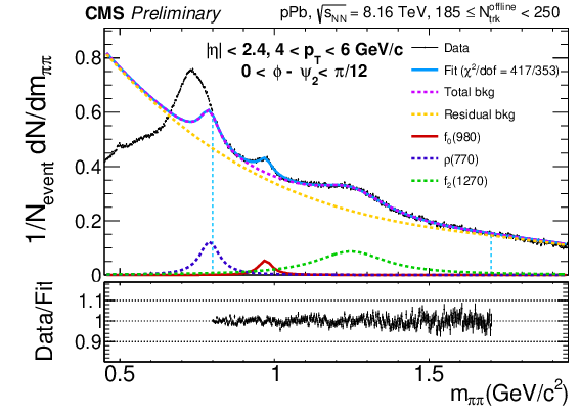
png pdf |
Figure 2:
The same-sign combinatorial background subtracted invariant mass spectrum for pair transverse momentum 4 <pT< 6 GeV/c and azimuthal angle 0 <ϕ−ψ2<π/ 12 in high-multiplicity (185 ≤Nofflinetrk< 250) pPb collisions at √sNN= 8.16 TeV. The solid blue curve is the fit result where the blue dashed lines indicate the fitting range; the orange dashed curve represents the residual background, and the violet dashed line represents the total background. Solid red curve represent f0(980) signal, while the dashed deep violet and green curves represent the background contributions from ρ(770) and f2(1270), respectively. The ratio between data and fit is shown in the bottom panel. Error bars show statistical uncertainties. |

png pdf |
Figure 3:
The f0(980) yield for 4 <pT< 6 GeV/c as a function of ϕ−ψ2 in high-multiplicity pPb collisions at √sNN= 8.16 TeV. Error bars show statistical uncertainties. The red curve is a fit to Eq. (1) with only the n= 2 term. |

png pdf |
Figure 4:
The elliptic anisotropy v2 and the nonflow-subtracted vsub2 of the f0(980) as functions of pT within pseudorapidity |η|< 2.4 in high-multiplicity 185 ≤Nofflinetrk< 250 pPb collisions at √sNN= 8.16 TeV. Error bars show statistical uncertainties, while the shaded areas represent systematic uncertainties. |

png pdf |
Figure 4-a:
The elliptic anisotropy v2 and the nonflow-subtracted vsub2 of the f0(980) as functions of pT within pseudorapidity |η|< 2.4 in high-multiplicity 185 ≤Nofflinetrk< 250 pPb collisions at √sNN= 8.16 TeV. Error bars show statistical uncertainties, while the shaded areas represent systematic uncertainties. |
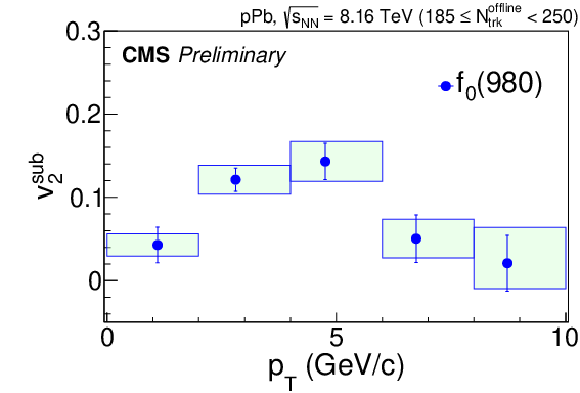
png pdf |
Figure 4-b:
The elliptic anisotropy v2 and the nonflow-subtracted vsub2 of the f0(980) as functions of pT within pseudorapidity |η|< 2.4 in high-multiplicity 185 ≤Nofflinetrk< 250 pPb collisions at √sNN= 8.16 TeV. Error bars show statistical uncertainties, while the shaded areas represent systematic uncertainties. |
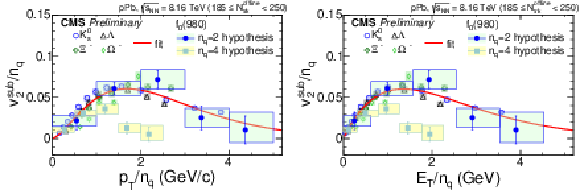
png pdf |
Figure 5:
The vsub2/nq of f0(980) (with nq= 2 and 4) as functions of pT/nq (left panel) and ET/nq (right panel), compared with those of other hadrons (K0S, Λ, Ξ−, Ω− strange hadrons) in high-multiplicity 185 ≤Nofflinetrk< 250 pPb collisions at √sNN= 8.16 TeV. Error bars show statistical uncertainties, while the shaded areas represent systematic uncertainties. The red curves are the NCQ scaling parameterizations to the data of the other hadrons. |
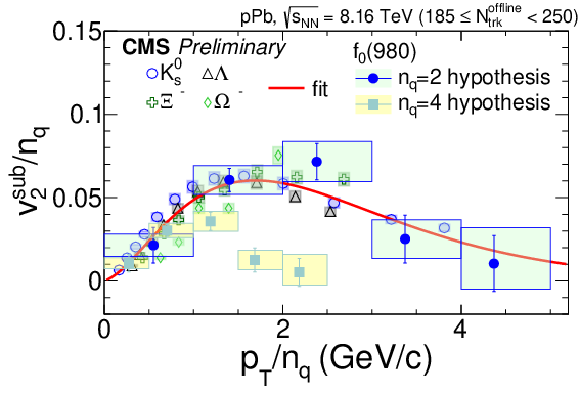
png pdf |
Figure 5-a:
The vsub2/nq of f0(980) (with nq= 2 and 4) as functions of pT/nq (left panel) and ET/nq (right panel), compared with those of other hadrons (K0S, Λ, Ξ−, Ω− strange hadrons) in high-multiplicity 185 ≤Nofflinetrk< 250 pPb collisions at √sNN= 8.16 TeV. Error bars show statistical uncertainties, while the shaded areas represent systematic uncertainties. The red curves are the NCQ scaling parameterizations to the data of the other hadrons. |
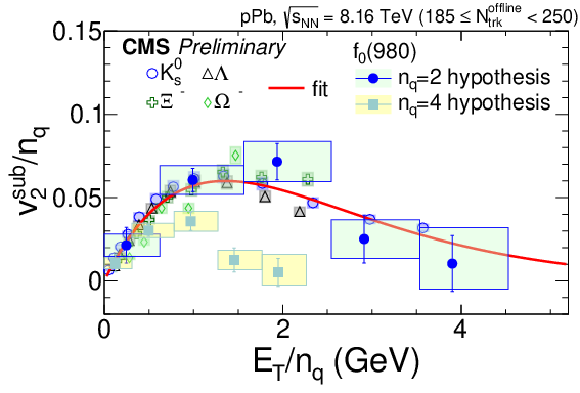
png pdf |
Figure 5-b:
The vsub2/nq of f0(980) (with nq= 2 and 4) as functions of pT/nq (left panel) and ET/nq (right panel), compared with those of other hadrons (K0S, Λ, Ξ−, Ω− strange hadrons) in high-multiplicity 185 ≤Nofflinetrk< 250 pPb collisions at √sNN= 8.16 TeV. Error bars show statistical uncertainties, while the shaded areas represent systematic uncertainties. The red curves are the NCQ scaling parameterizations to the data of the other hadrons. |

png pdf |
Figure 6:
The log-likelihood ratio distributions for hypotheses nq= 2 and nq= 4 from the pseudoexperiments and the observed value (0 <pT< 10 GeV/c). |
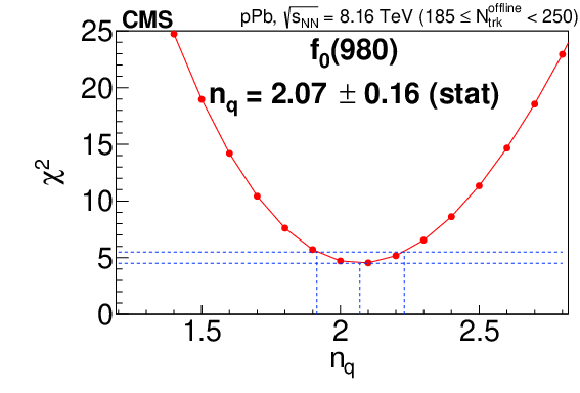
png pdf |
Figure 7:
The χ2 of the f0(980) elliptic flow data from the NCQ-scaling parameterization, scanned in steps of nq. |

png pdf |
Figure 8:
Same as Fig. 6 but using f0(980)vsub2 data within restricted pT ranges of pT< 8 GeV/c (left panel) and pT< 6 GeV/c (right panel). |
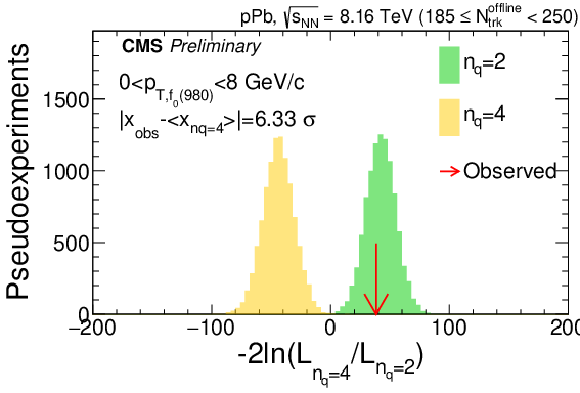
png pdf |
Figure 8-a:
Same as Fig. 6 but using f0(980)vsub2 data within restricted pT ranges of pT< 8 GeV/c (left panel) and pT< 6 GeV/c (right panel). |

png pdf |
Figure 8-b:
Same as Fig. 6 but using f0(980)vsub2 data within restricted pT ranges of pT< 8 GeV/c (left panel) and pT< 6 GeV/c (right panel). |

png pdf |
Figure 9:
The log-likelihood ratio distributions for hypotheses nq= 2 and nq= 3 from the pseudoexperiments and the observed value. |

png pdf |
Figure 10:
The χ2 of the f0(980) elliptic flow data from the NCQ-scaling parameterization, scanned in steps of nq. The three curves correspond to using f0(980) data from pT< 6 GeV/c, pT< 8 GeV/c, and pT< 10 GeV/c, respectively. |
| Tables | |

png pdf |
Table 1:
Sources and magnitudes of the uncertainties in the extracted nq of the f0(980) with data from pT< 10 GeV/c. |
| Summary |
| In summary, the f0(980) yields are extracted at midrapidity (|η|< 2.4) from the invariant mass spectra of its main π+π− decay channel in high-multiplicity pPb collisions at √sNN= 8.16 TeV by the CMS experiment at the LHC. The elliptic flow anisotropy v2 of the f0(980) is measured as a function of pT up to 10 GeV/c, with respect to the second-order harmonic plane reconstructed from forward/backward energies. Nonflow contamination is estimated from K0S measurements and is subtracted. By comparing the nonflow-subtracted vsub2 of the f0(980) to those of K0S, Λ, Ξ−, and Ω under the NCQ scaling hypothesis, we found evidence that the f0(980) hadron is a normal quark-antiquark state. The f0(980) is 7.7 standard deviations away from being a nq= 4 tetraquark state or K¯K molecule. The significance is 6.3 σ and 3.1 σ respectively, if only the restricted pT range of pT< 8 GeV/c and pT< 6 GeV/c is considered. The f0(980) data in pT< 8 GeV/c are found to be 3.5 σ away from the NCQ scaling with nq= 3, characteristic of a quark-antiquark-gluon hybrid state. The number of constituent quarks nq of the f0(980) is also extracted, and is consistent with the value of 2. Our experimental determination of the quark content of the f0(980) with high confidence under this novel approach is expected to stimulate further experimental investigations as well as theoretical studies. Those future endeavors will likely advance our understanding of QCD and Nature. |
| References | ||||
| 1 | M. Gell-Mann | A Schematic Model of Baryons and Mesons | PL 8 (1964) 214 | |
| 2 | G. Zweig | An SU(3) model for strong interaction symmetry and its breaking. Version 2 | in Developments in the Quark Theory of Hadrons, Vol. 1, 1964-1978 link |
|
| 3 | R. L. Jaffe | Perhaps a Stable Dihyperon | PRL 38 (1977) 195 | |
| 4 | R. L. Jaffe | Exotica | Phys. Rept. 409 (2005) 1 | hep-ph/0409065 |
| 5 | Belle Collaboration | Observation of a narrow charmonium-like state in exclusive B±→K±π+π−J/ψ decays | PRL 91 (2003) 262001 | hep-ex/0309032 |
| 6 | LHCb Collaboration | Observation of J/ψp Resonances Consistent with Pentaquark States in Λ0b→J/ψK−p Decays | PRL 115 (2015) 072001 | 1507.03414 |
| 7 | LHCb Collaboration | Observation of a narrow pentaquark state, Pc(4312)+, and of two-peak structure of the Pc(4450)+ | PRL 122 (2019) 222001 | 1904.03947 |
| 8 | LHCb Collaboration | Observation of B0(s)→J/ψp¯p decays and precision measurements of the B0(s) masses | PRL 122 (2019) 191804 | 1902.05588 |
| 9 | LHCb Collaboration | Observation of an exotic narrow doubly charmed tetraquark | Nature Phys. 18 (2022) 751 | 2109.01038 |
| 10 | LHCb Collaboration | Study of the doubly charmed tetraquark T+cc | Nature Commun. 13 (2022) 3351 | 2109.01056 |
| 11 | H.-X. Chen, W. Chen, X. Liu, and S.-L. Zhu | The hidden-charm pentaquark and tetraquark states | Phys. Rept. 639 (2016) 1 | 1601.02092 |
| 12 | A. Esposito, A. Pilloni, and A. D. Polosa | Multiquark Resonances | Phys. Rept. 668 (2017) 1 | 1611.07920 |
| 13 | N. Brambilla et al. | The XYZ states: experimental and theoretical status and perspectives | Phys. Rept. 873 (2020) 1 | 1907.07583 |
| 14 | S. D. Protopopescu et al. | ππ Partial Wave Analysis from Reactions π+p→π+π−Δ++ and π+p→K+K−Δ++ at 7.1 GeV/c | PRD 7 (1973) 1279 | |
| 15 | B. Hyams et al. | ππ Phase Shift Analysis from 600-MeV to 1900-MeV | NPB 64 (1973) 134 | |
| 16 | G. Grayer et al. | High Statistics Study of the Reaction π−p→π−π+n: Apparatus, Method of Analysis, and General Features of Results at 17 GeV/c | NPB 75 (1974) 189 | |
| 17 | R. L. Jaffe | Multi-Quark Hadrons. 1. The Phenomenology of (2 Quark 2 anti-Quark) Mesons | PRD 15 (1977) 267 | |
| 18 | J. D. Weinstein and N. Isgur | K anti-K Molecules | PRD 41 (1990) 2236 | |
| 19 | F. E. Close and N. A. Tornqvist | Scalar mesons above and below 1-GeV | JPG 28 (2002) R249 | hep-ph/0204205 |
| 20 | C. Amsler and N. A. Tornqvist | Mesons beyond the naive quark model | Phys. Rept. 389 (2004) 61 | |
| 21 | L. Maiani, F. Piccinini, A. D. Polosa, and V. Riquer | A New look at scalar mesons | PRL 93 (2004) 212002 | hep-ph/0407017 |
| 22 | D. V. Bugg | Four sorts of meson | Phys. Rept. 397 (2004) 257 | hep-ex/0412045 |
| 23 | E. Klempt and A. Zaitsev | Glueballs, Hybrids, Multiquarks. Experimental facts versus QCD inspired concepts | Phys. Rept. 454 (2007) 1 | 0708.4016 |
| 24 | G. 't Hooft et al. | A Theory of Scalar Mesons | PLB 662 (2008) 424 | 0801.2288 |
| 25 | J. R. Pelaez | From controversy to precision on the sigma meson: a review on the status of the non-ordinary f0(500) resonance | Phys. Rept. 658 (2016) 1 | 1510.00653 |
| 26 | F.-K. Guo et al. | Hadronic molecules | Rev. Mod. Phys. 90 (2018) 015004 | 1705.00141 |
| 27 | T. Barnes | Two Photon Decays Support the (K anti-K) Molecule Picture of the S* (975) and Delta (980) | PLB 165 (1985) 434 | |
| 28 | Z. P. Li, F. E. Close, and T. Barnes | Relativistic effects in gamma gamma decays of P wave positronium and q anti-q systems | PRD 43 (1991) 2161 | |
| 29 | R. Delbourgo, D.-s. Liu, and M. D. Scadron | s anti-s dominance of the f(0)(980) meson | PLB 446 (1999) 332 | hep-ph/9811474 |
| 30 | J. L. Lucio Martinez and M. Napsuciale | a(0)(980) → gamma gamma and f(0)(980) → gamma gamma: A Consistent description | PLB 454 (1999) 365 | hep-ph/9903234 |
| 31 | T. Branz, T. Gutsche, and V. E. Lyubovitskij | f0(980) meson as a K anti-K molecule in a phenomenological Lagrangian approach | --317, 2008 Eur. Phys. J. A 37 (2008) 303 |
0712.0354 |
| 32 | C. Hanhart, Y. S. Kalashnikova, A. E. Kudryavtsev, and A. V. Nefediev | Two-photon decays of hadronic molecules | PRD 75 (2007) 074015 | hep-ph/0701214 |
| 33 | R. H. Lemmer | Calculation of the two-photon decay width of the f(0)(980) scalar meson | PLB 650 (2007) 152 | hep-ph/0701027 |
| 34 | M. R. Pennington, T. Mori, S. Uehara, and Y. Watanabe | Amplitude Analysis of High Statistics Results on gamma gamma → pi+ pi- and the Two Photon Width of Isoscalar States | EPJC 56 (2008) 1 | 0803.3389 |
| 35 | M. Boglione and M. R. Pennington | Determination of radiative widths of scalar mesons from experimental results on gamma gamma → pi pi | EPJC 9 (1999) 11 | hep-ph/9812258 |
| 36 | N. N. Achasov and G. N. Shestakov | Lightest scalar and tensor resonances in gamma gamma → pi pi after the Belle experiment | PRD 77 (2008) 074020 | 0712.0885 |
| 37 | M. N. Achasov et al. | The phi(1020) → pi0 pi0 gamma decay | PLB 485 (2000) 349 | hep-ex/0005017 |
| 38 | M. Boglione and M. R. Pennington | Towards a model independent determination of the phi → f0 gamma coupling | EPJC 30 (2003) 503 | hep-ph/0303200 |
| 39 | KLOE Collaboration | Study of the decay ϕ→f(0)(980)γ→π+π−γ with the KLOE detector | PLB 634 (2006) 148 | hep-ex/0511031 |
| 40 | KLOE Collaboration | Dalitz plot analysis of e+e−→π0π0γ events at √s approximately M(ϕ) with the KLOE detector | EPJC 49 (2007) 473 | hep-ex/0609009 |
| 41 | A. Deandrea et al. | The s anti-s and K anti-K nature of f0(980) D(s) decays | PLB 502 (2001) 79 | hep-ph/0012120 |
| 42 | CLEO Collaboration | Study of the semileptonic decay D(s)+ → f0(980) e+ nu and implications for B(s) → J/psi f(0) | PRD 80 (2009) 052009 | 0907.3201 |
| 43 | S. Stone and L. Zhang | Use of B→J/ψf0 decays to discern the qˉq or tetraquark nature of scalar mesons | PRL 111 (2013) 062001 | 1305.6554 |
| 44 | LHCb Collaboration | Measurement of resonant and CP components in ˉB0s→J/ψπ+π− decays | PRD 89 (2014) 092006 | 1402.6248 |
| 45 | LHCb Collaboration | Measurement of the resonant and CP components in ¯B0→J/ψπ+π− decays | PRD 90 (2014) 012003 | 1404.5673 |
| 46 | J. T. Daub, C. Hanhart, and B. Kubis | A model-independent analysis of final-state interactions in ¯B0d/s→J/ψππ | JHEP 02 (2016) 009 | 1508.06841 |
| 47 | B. S. Zou and D. V. Bugg | Is f0 (975) a narrow resonance? | PRD 48 (1993) R3948 | |
| 48 | Z.-Q. Wang, X.-W. Kang, J. A. Oller, and L. Zhang | Analysis on the composite nature of the light scalar mesons f0(980) and a0(980) | PRD 105 (2022) 074016 | 2201.00492 |
| 49 | Particle Data Group Collaboration | Review of Particle Physics | Spectroscopy of Light Meson Resonances, Scalar Mesons below 1 GeV, PTEP 2022 (2022) 083C01 |
|
| 50 | CMS Collaboration | Evidence for X(3872) in Pb-Pb Collisions and Studies of its Prompt Production at √sNN=5.02\,\,TeV | PRL 128 (2022) 032001 | CMS-HIN-19-005 2102.13048 |
| 51 | STAR Collaboration Collaboration | Experimental and theoretical challenges in the search for the quark gluon plasma: The STAR Collaboration's critical assessment of the evidence from RHIC collisions | Nucl.Phys. A 757 (2005) 102 | nucl-ex/0501009 |
| 52 | PHENIX Collaboration Collaboration | Formation of dense partonic matter in relativistic nucleus-nucleus collisions at RHIC: Experimental evaluation by the PHENIX collaboration | Nucl.Phys. A 757 1(2005) 84 | nucl-ex/0410003 |
| 53 | G. Roland, K. Safarik, and P. Steinberg | Heavy-ion collisions at the LHC | Prog. Part. Nucl. Phys. 77 (2014) 70 | |
| 54 | S. T. Butler and C. A. Pearson | Deuterons from High-Energy Proton Bombardment of Matter | PR 129 (1963) 836 | |
| 55 | C. B. Dover, U. W. Heinz, E. Schnedermann, and J. Zimanyi | Relativistic coalescence model for high-energy nuclear collisions | Phys. Rev. C 44 (1991) 1636 | |
| 56 | R. J. Fries, B. Muller, C. Nonaka, and S. A. Bass | Hadron production in heavy ion collisions: Fragmentation and recombination from a dense parton phase | Phys. Rev. C 68 (2003) 044902 | nucl-th/0306027 |
| 57 | R. J. Fries, B. Muller, C. Nonaka, and S. A. Bass | Hadronization in heavy ion collisions: Recombination and fragmentation of partons | PRL 90 (2003) 202303 | nucl-th/0301087 |
| 58 | V. Greco, C. M. Ko, and P. Levai | Parton coalescence and anti-proton / pion anomaly at RHIC | PRL 90 (2003) 202302 | nucl-th/0301093 |
| 59 | V. Greco, C. M. Ko, and P. Levai | Parton coalescence at RHIC | Phys. Rev. C 68 (2003) 034904 | nucl-th/0305024 |
| 60 | R. C. Hwa and C. B. Yang | Scaling behavior at high pT and the p/π ratio | Phys. Rev. C 67 (2003) 034902 | nucl-th/0211010 |
| 61 | R. C. Hwa and C. B. Yang | Recombination of shower partons at high pT in heavy ion collisions | Phys. Rev. C 70 (2004) 024905 | nucl-th/0401001 |
| 62 | R. J. Fries, V. Greco, and P. Sorensen | Coalescence Models For Hadron Formation From Quark Gluon Plasma | Ann. Rev. Nucl. Part. Sci. 58 (2008) 177 | 0807.4939 |
| 63 | V. Minissale, F. Scardina, and V. Greco | Hadrons from coalescence plus fragmentation in AA collisions at energies available at the BNL Relativistic Heavy Ion Collider to the CERN Large Hadron Collider | Phys. Rev. C 92 (2015) 054904 | 1502.06213 |
| 64 | J.-Y. Ollitrault | Anisotropy as a signature of transverse collective flow | PRD 46 (1992) | |
| 65 | A. Gu, T. Edmonds, J. Zhao, and F. Wang | Elliptical flow coalescence to identify the f0(980) content | Phys. Rev. C 101 (2020) 024908 | 1902.07152 |
| 66 | S. Voloshin and Y. Zhang | Flow study in relativistic nuclear collisions by Fourier expansion of Azimuthal particle distributions | Z. Phys. C 70 (1996) 665 | hep-ph/9407282 |
| 67 | D. Molnar and S. A. Voloshin | Elliptic flow at large transverse momenta from quark coalescence | PRL 91 (2003) 092301 | nucl-th/0302014 |
| 68 | L. Maiani, A. D. Polosa, V. Riquer, and C. A. Salgado | Counting valence quarks at RHIC and LHC | PLB 645 (2007) | hep-ph/0606217 |
| 69 | ExHIC Collaboration | Multi-quark hadrons from Heavy Ion Collisions | PRL 106 (2011) 212001 | 1011.0852 |
| 70 | A. Gu and F. Wang | Transverse momentum spectra of f0(980) from coalescence model | 2306.08584 | |
| 71 | STAR Collaboration | Particle type dependence of azimuthal anisotropy and nuclear modification of particle production in Au + Au collisions at √sNN= 200 GeV | PRL 92 (2004) 052302 | nucl-ex/0306007 |
| 72 | STAR Collaboration | Azimuthal anisotropy in Au+Au collisions at √sNN= 200 GeV | Phys. Rev. C 72 (2005) 014904 | nucl-ex/0409033 |
| 73 | STAR Collaboration | Multi-strange baryon elliptic flow in Au + Au collisions at √sNN= 200 GeV | PRL 95 (2005) 122301 | nucl-ex/0504022 |
| 74 | PHENIX Collaboration | Scaling properties of azimuthal anisotropy in Au+Au and Cu+Cu collisions at √sNN= 200 GeV | PRL 98 (2007) 162301 | nucl-ex/0608033 |
| 75 | STAR Collaboration | Partonic flow and phi-meson production in Au + Au collisions at √sNN= 200 GeV | PRL 99 (2007) 112301 | nucl-ex/0703033 |
| 76 | STAR Collaboration | Elliptic flow of identified hadrons in Au+Au collisions at √sNN= 7.7-62.4 GeV | Phys. Rev. C 88 (2013) 014902 | 1301.2348 |
| 77 | ALICE Collaboration | Elliptic flow of identified hadrons in Pb-Pb collisions at √sNN= 2.76 TeV | JHEP 06 (2015) 190 | 1405.4632 |
| 78 | ALICE Collaboration | Anisotropic flow of identified particles in Pb-Pb collisions at √sNN= 5.02 TeV | JHEP 09 (2018) 006 | 1805.04390 |
| 79 | CMS Collaboration | Long-range two-particle correlations of strange hadrons with charged particles in pPb and PbPb collisions at LHC energies | PLB 742 (2015) 200 | CMS-HIN-14-002 1409.3392 |
| 80 | CMS Collaboration | Elliptic flow of charm and strange hadrons in high-multiplicity pPb collisions at √sNN= 8.16 TeV | PRL 121 (2018) 082301 | CMS-HIN-17-003 1804.09767 |
| 81 | ALICE Collaboration | Non-linear flow modes of identified particles in Pb-Pb collisions at √sNN= 5.02 TeV | JHEP 06 (2020) 147 | 1912.00740 |
| 82 | ALICE Collaboration | Anisotropic flow of identified hadrons in Xe-Xe collisions at √sNN= 5.44 TeV | JHEP 10 (2021) 152 | 2107.10592 |
| 83 | ALICE Collaboration | Anisotropic flow and flow fluctuations of identified hadrons in Pb-Pb collisions at √sNN= 5.02 TeV | JHEP 05 (2023) 243 | 2206.04587 |
| 84 | CMS Collaboration | The CMS Experiment at the CERN LHC | JINST 3 (2008) S08004 | |
| 85 | CMS Collaboration | The CMS trigger system | no.~01, P0, 2017 JINST 12 (2017) |
CMS-TRG-12-001 1609.02366 |
| 86 | CMS Collaboration | Observation of Correlated Azimuthal Anisotropy Fourier Harmonics in pp and p+Pb Collisions at the LHC | no.~9, 092301, 2018 PRL 120 (2018) |
CMS-HIN-16-022 1709.09189 |
| 87 | CMS Collaboration | Constraints on the chiral magnetic effect using charge-dependent azimuthal correlations in pPb and PbPb collisions at the CERN Large Hadron Collider | Phys. Rev. C 97 (2018) 044912 | CMS-HIN-17-001 1708.01602 |
| 88 | CMS Collaboration | Description and performance of track and primary-vertex reconstruction with the CMS tracker | no.~10, P9, 2014 JINST 9 (2014) |
CMS-TRK-11-001 1405.6569 |
| 89 | M. Gyulassy and X.-N. Wang | HIJING 1.0: A Monte Carlo program for parton and particle production in high-energy hadronic and nuclear collisions | Comput. Phys. Commun. 83 (1994) 307 | nucl-th/9502021 |
| 90 | GEANT4 Collaboration | GEANT4--a simulation toolkit | NIM A 506 (2003) | |
| 91 | A. M. Poskanzer and S. A. Voloshin | Methods for analyzing anisotropic flow in relativistic nuclear collisions | Phys. Rev. C 58 (1998) 1671 | nucl-ex/9805001 |
| 92 | V. Weisskopf and E. P. Wigner | Calculation of the natural brightness of spectral lines on the basis of Dirac's theory | Z. Phys. 63 (1930) | |
| 93 | H. Hull and G. Breit | Coulomb Wave Functions | Springer Berlin Heidelberg, Berlin, Heidelberg, 1959 link |
|
| 94 | STAR Collaboration | Rho0 production and possible modification in Au+Au and p+p collisions at √sNN= 200 GeV | PRL 92 (2004) 092301 | nucl-ex/0307023 |
| 95 | R. Barlow | Systematic errors: Facts and fictions | in Conference on Advanced Statistical Techniques in Particle Physics, 2002 | hep-ex/0207026 |
| 96 | P. T. Matthews and A. Salam | Relativistic theory of unstable particles. 2 | PR 115 (1959) | |
| 97 | R. A. Kycia and S. Jadach | Relativistic Voigt profile for unstable particles in high energy physics | J. Math. Anal. Appl. 463 (2018) 2 | 1711.09304 |
| 98 | PHENIX Collaboration | Deviation from quark-number scaling of the anisotropy parameter v2 of pions, kaons, and protons in Au+Au collisions at √sNN= 200 GeV | Phys. Rev. C 85 (2012) 064914 | 1203.2644 |
| 99 | ALICE Collaboration | Higher harmonic flow coefficients of identified hadrons in Pb-Pb collisions at √sNN= 2.76 TeV | JHEP 09 (2016) 164 | 1606.06057 |

|
Compact Muon Solenoid LHC, CERN |

|

|

|

|

|

|